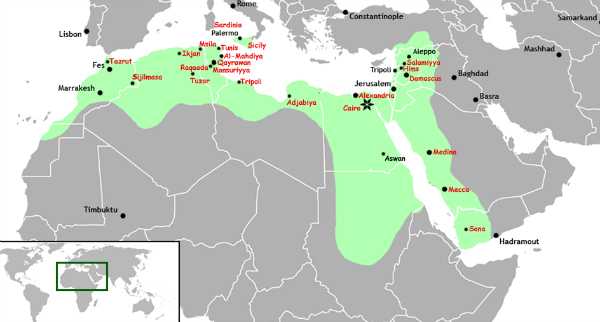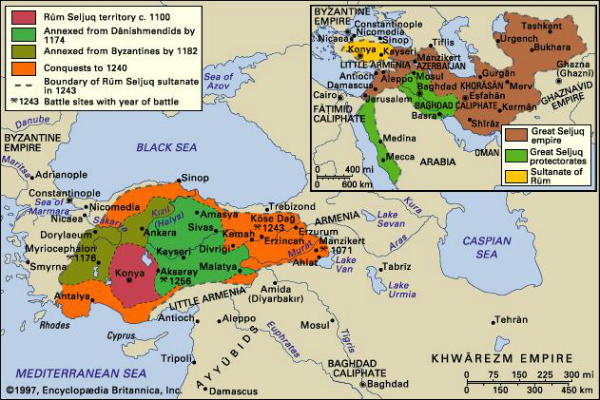The Abbasid Dynasty lasted from 750 until 1258. It was during this period that many of Islam’s structures began to solidify. The Qur’an, hadith, traditions (sunna), and schools of legal jurisprudence (Shri’a) all formed during this time. Governance structures also solidified during this period. These changes had significant impacts on the various peoples conquered by the early caliphs and the Umayyad. Due to the nature and extent of the changes occurring within Islam during this period, there will be three articles concerning this dynasty. This article will focus on the history from this period. The second on the development of religious doctrine, and the third on the conquered peoples within the caliphate (the Dhimmis).
Although this is often thought of as Islam’s Golden Age, it should be noted that there was much upheaval and infighting that occurred during this time. The changes occurring during this period are both significant in terms of Islam’s development and complex. We will specifically look at the rise and fall of both the Fatamid and Seljuk Turk kingdoms within the caliphate that occurred during this period, and conclude with the crusades and Mongol invasion that ultimately ended Abbasid rule.
This is a good time to remind the reader once again that the intent of this series is not to tell you what to think, but instead to simply present the facts, and provide you with references where you can find more information if you want it. It is also time to reiterate that the subject of these articles is Islam and not Muslims. These articles cover the development of Islam’s tenets, and not its people. We are each defined by the choices that we make.
A Shift in Power
The Abbasid overthrew the Umayyad in 750. They moved the capital to Baghdad and the caliphate came under a greater Persian influence. This was not just a political revolution, but a religious one as well. The Abbasid viewed themselves not only as the rulers of the caliphate, but as princes and kings of Islam. They were much more rigorous in applying the principles of Islam, and were much more intolerant of other religions. They set about creating a theocratic state, based upon the Persian model ‘in which church and state are conjoined.’[1] For Sunni Islam (which the Abbasid represent),
‘the caliph is there to guarantee the carrying out of Islamic obligations, to represent and embody in his person the duties of the Islamic community. “At the head of the Muslims … There must necessarily stand someone who sees to it that their laws are carried out, their statutes maintained, their borders defended, and their armies equipped, who makes sure that their obligatory taxes are collected, that men of violence, thieves, and highwaymen are suppressed, that services are held on Fridays and feast days, that minors (in need of a guardian) can be married, that the spoils of war are justly divided, and that similar legal obligations, which no single member of the community can take care of, are performed.”’[2]
This dynasty traced its roots back to one of Mohammad’s uncles – Al-Abbas. They went out of their way to show respect for the Umayyad that they replaced. However, they viewed the followers of Muhammad’s cousin Ali (the Shi’a) as rivals as they also had a blood line claim to rule within the caliphate. During their rule the Shi’a were persecuted by the Abbasid. In the words of Goldziher, ‘Having plucked for themselves the fruit of Shi’a propaganda, the Abbasid had all the more reason to be on their guard against continued subversion by those who would not regard them, any more than the Umayyad, as the rightful successors of the Prophet. They strove therefore to deflect people from the veneration of Ali. Al-Mutawakkil razed the tomb of Husayn. People were not to recall at that sacred place that it was a son of Ali, and not a descendant of Abbas, who had shed his blood for the rights of the Prophet’s house … During Abbasid rule, some [Shi’a] ended their lives in prison, some on the scaffold, some by secretly administered poison.’[3]
Under the Abbasid, the administration of the empire was delegated to bureaucrats. Viziers created decrees to be signed by the caliph. The Arab army was replaced by hired provincials, including Turkish mercenaries (the Mamluks). Persecution of non-Muslims within the empire increased during this time. In 772 the hands of Jews and Christians were ordered stamped. Monasteries were sacked and burned, and many of the monks were killed. The persecution became so severe that by the ninth century, many Christians fled to Constantinople and other Christian cities outside of the reach of Islam. (See the forthcoming article on the treatment of Dhimmis).
The Fatamid
But the Abbasid rule was not readily accepted by all. From about 909 – 1171 there arose a Fatamid Dynasty within the caliphate. They took their name from one of Muhammad’s daughters Fatima, from whom they claimed descent (along with her husband Ali) – providing justification for the Abbasid concern about rivals who would also claim descent from Muhammad. The Fatamid were Shi’a and their rise was in part a response to the Abbasid persecution of their sect. They viewed the Abbasid caliphs as usurpers and dedicated themselves to overthrowing the religious and political order they created. The Fatamid rulers viewed themselves as spiritual leaders (imams). They were initially able to establish a firm base within Yemen. By 909 they were strong enough for their imam to come out of hiding and declare himself al-Mahdi (Divinely Guided One).
They established a base in modern Tunisia and spread through North Africa and into Sicily during the first half of the 10th century. During this time they added the third branch of missions (religion) to the military and political branches of governance. While still keeping up the wars with Europe, and internal divisions with the Berbers, the Fatamid turned eastward and toward the Abbasid. Finally, after several years of unsuccessful campaigns, the Fatamid broke through the Abbasid defenses in 969 and took portions of the Nile valley, Sinai Peninsula, Palestine, and southern Syria. Shortly after the conquest of Egypt they founded the city of Cairo. At their height, they moved as far east as Yemen, the Hijaz on the Arabian Peninsula, and up into Anatolia. They briefly occupied Baghdad in about 1057 when a dissident general in Iraq joined the Fatamid. However, they were driven back by the Seljuq Turks a few years later. The map below shows the extent of their rule at its height.

Figure 1: Fatamid Dynasty[4]
However, their rule collapsed and they were gone a little over a century later. There are several events that all conspired to their demise. These included their religious doctrine being unacceptable to the Sunni majority; the Sunni revival of the 11th and 12th centuries made that rejection a certainty. The occurrence of the Crusades beginning in the 11th century also contributed to their defeat as there was no room for infighting amongst the Muslim sects during that time. Finally, the later years of the Fatamid were marked by infighting amongst Berber, Turkish, Sudanese, and Nubian troops. These were exacerbated by plagues and famines during the final years. The Fatamid reign ended in 1171 when Saladin became the ruler of Egypt and once again established Sunni Islam there.
Seljuk Turks
The Seljuk Turks were driven into southwestern Asia as a result of the Mongols sweeping across Asia. The Seljuk were a warrior race and accepted Sunni Islam when they came in contact with the Abbasid. ‘The Islamization of the Turks within the Muslim empire integrated new and unlimited forces. Uncouth and hardy, they had, since the ninth century, supplied contingents of slaves exclusively reserved for the Abbasid caliph’s guard and for military service. Thus, quite naturally, the ideology and tactics of jihad inflamed the warlike tendencies of the tribes, already roaming the Asiatic borders of the Greek and Armenian lands. They joined its ranks with the enthusiasm of neophytes and their ravages facilitated the Islamization and Turkification of Armenia, the Greek territories of Anatolia and the Balkans. Yet, it is also true that their depredations could not be controlled by the Muslim state and often harmed its economic interests.’[5] The Turks swept westward and eventually took control of the empire, and effectively ran the empire, with the Persians, after about 945. The Seljuk adopted the culture and language of their Persian instructors as they had no Islamic heritage or strong literary heritage of their own. This led to the adoption of the Persian language throughout the area that is now Iran.
As mentioned above, the Seljuk drove the forces allied with the Fatamid from Baghdad and were seen as restorers of Sunni unity within Islam. They continued to push westward until they reached the frontier of Egypt. In the east, in 1071 the Seljuk defeated the Byzantine army at Manzikert (in Anatolia) and captured its emperor Romanus IV Diogenes. This opened the way for the Turkish settlement of Anatolia. After settling into Anatolia, they became mercenaries and found employment among rival Byzantine factions that were all vying for the throne in Constantinople. After the start of the Crusades, the Seljuk found themselves hemmed in by the Byzantine on the west and the crusaders on the east. Their practice of dividing provinces among all of a ruler’s sons led to internal power struggles and instability. They continued to weaken and by the time of the Mongol invasion, they were unable to defend themselves and disappeared as an autonomous power early in the 13th century.
The Seljuk Empire left a significant imprint on Islam from both a religious and political perspective. They created a series of madrasahs to provide uniform training for both administrators and religious scholars. Below is a map of the Seljuk Empire at its height (the inset) and the area under its control toward the end of its reign.

Figure 2: Seljuk Empire[6]
Byzantine Response
The advances by the Abbasid put the Byzantines into a defensive posture. However, in response to the persecution of non-Muslims within the caliphate, the Byzantines switched from a defensive posture to an offensive one against the Muslims. Beginning in 960, the Byzantine Emperor Nicephorus Phocas began retaking some territory from the Muslims, reclaiming Crete, Cyprus, Cilicia, and portions of Syria – including Antioch. Muslims were obliged to wage war to reclaim a part of dar al-Islam. Forces were brought from all parts of the Muslim empire, but the efforts were hampered by the split between Shia and Sunni. A ten year treaty was signed in 1001 by Basil II. However, the truce was not long-lived. In 1004 the sixth Abbasid caliph, Abu ‘Ali al-Mansur rebelled violently against the faith of his Christian mother and uncles (two of whom were patriarchs). He ordered churches destroyed, crosses burned, and all church properties to be confiscated. It is estimated that over 30,000 churches were destroyed over the next 10 years, including the rebuilt Church of the Sepulcher in Jerusalem. He also implemented decrees intended to humiliate Jews and Christians, such as the wearing of extremely heavy crosses, and idols in the shape of calves for Jews. In 1021, the caliph mysteriously disappeared.
The End of the Abbasid – The Crusades, Mongols, and Mamluks
As noted above, the Seljuk Turks moved west into Persia and Asia Minor in the 11th century, fleeing the advance of the Mongols under Genghis Khan. Beginning in 1070 they took portions of Asia Minor and retook Syria. Jerusalem was sacked, and a sultanate established in Nicaea. The Byzantine Empire had been reduced to an area a little larger than Greece. At this time the emperor Alexius I Comnenus appealed to Rome for help.
The Crusades (1095 – 1250)
During the Middle Ages, the practice of going on pilgrimages to religious shrines housing various artifacts of the saints developed. There were many shrines throughout Europe and the Middle East, but three cities stood out in importance. These were Rome, Santiago de Compostela (Spain), and Jerusalem. To support and protect travelers on their journeys to and from a shrine numerous charitable organizations developed throughout Europe, including hospitals, hospices, and bridge brotherhoods. By the time of the High Middle Ages, every town and most villages came have one or more of these charitable organizations. Military orders developed to provide these same services to areas under Islamic control, and the role of these organizations latter grew to include serving in the negotiation and ransoming of war captives during the crusades.[7]
Pope Urban II called for the First Crusade at the Council of Clermont in 1095. The crusades were a defensive war waged to:
- Stem Muslim aggression, as almost two thirds of what had been the lands of Christendom had at this time been conquered by the early caliphs, Umayyad, and Abbasid.
- End the mistreatment of Christians living in Muslim lands (see the third article in this series on the treatment of Dhimmis).
- End the harassment of Christian pilgrims traveling in the Holy Land.
Some short-lived success was achieved. The first crusade retook parts of Anatolia and Syria from the Seljuk, and Palestine, including Jerusalem, from the Fatamid. There were seven crusades in all, each with varying objectives and degrees of success. However, there was much mistrust between the East and their western European allies, fueled in part by some Greek and Monophysite support being given to the Islamic forces. Also, many of the participants in the later crusades were third and fourth sons of nobles without any wealth or land of their own. They looted and pillaged across both Europe and Arabia in search of wealth to and from the crusades.
The Mongols and Mamluks
At the same time as the crusades were winding down, the Mongols were sweeping into western Asia. In 1253 Hulagu Khan, brother of Kublai Khan, was given the task of conquering what is now Iran, then under control of the Khwarezm – an independent Islamic dynasty that had wrested control of the area from the Seljuk Turks. He set out with an army of about 130,000 and founded the Il-Khanid dynasty in 1256. The Il-Khans reunited the area under the rule of a single political authority. At about this time Hulagu Khan sent an emissary to the European powers offering help against the Muslims. However, after the crusades the Christians were too disorganized to come to any specific agreement.
The Mongols destroyed Baghdad in 1258 and ended the Abbasid dynasty. They next swept through Iraq and Syria and headed toward Egypt. They were defeated by the Mamluks in Palestine in 1260. The Mamluks (derived from the Arabic word for slave) handed the Mongols their first known defeat in open combat, however they were neither Arab nor Egyptian. They were an imported force of Turkish and Circassian slave soldiers brought into Egypt with Saladin a century earlier. The Mamluk generals established their own sultanate upon the death of Al-Malik as-Salih Ayyub in 1249, and ruled Egypt and portions of Syria from about 1250 to 1517. They were Sunni, and this dynasty will be discussed further in conjunction with the Ottomans in a latter article.
As for the Mongols, by the end of the 13th century they lost all contact with the Mongol chieftains and embraced Islam. Their ruler Mahmud Ghazan embraced Sunni Islam, but his brother converted to Shia Islam early in the 14th century. This change gave rise to much internal conflict within the area ruled by the Il-Khans, which was somewhat averted when a subsequent ruler converted back to Sunni Islam. Internal disputes continued and the Il-Khanid dynasty disappeared by the middle of the 14th century.
[1] Goldziher, Ignaz, Introduction to Islamic Theology and Law, p. 46, Princeton University Press, 1981.
[2] Ibid, pp.182-3.
[3] Ibid, p. 137.
[4] http://simerg.com/literary-readings/great-moments-in-ismaili-history-the-establishment-of-the-fatimid-caliphate/
[5] Ye’or, Bat, The Decline of Eastern Christianity under Islam, p. 52, Farleigh-Dickenson University Press, 2006.
[6] http://www.britannica.com/topic/Fatimid-dynasty [7] Wolf, Dan, Charity and Society, forthcoming.
 Author and speaker, Dan Wolf, is gifted at gathering facts about contemporary subjects and sharing information in a manner that is easy to read and understand. Dan will be posting both historical and current information about Islam and Sharia on the VCA website.
Author and speaker, Dan Wolf, is gifted at gathering facts about contemporary subjects and sharing information in a manner that is easy to read and understand. Dan will be posting both historical and current information about Islam and Sharia on the VCA website.




